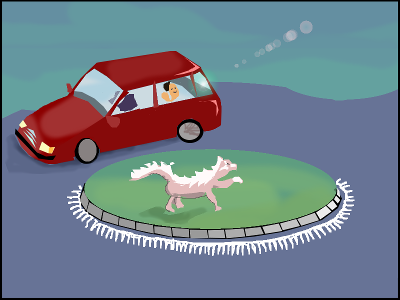Maybe you aren’t fully acquainted with the phenomenon of roundabout dogs. It is a statue of a dog, which somebody places in a roundabout, usually without applying for permission. It has been particularly common in Sweden, though it looks like it is mostly Scanians and x:th generation immigrants who do this, perhaps to make Swedish society feel less cold.

Typical roundabout dog
In Swedish, such a dog is called rundellhund, where rundell = ’roundabout’, actually the grass in the centre circle, and hund = ‘dog’. The most influential archetype would be Cirkulation II, by Stina Opitz, where a small dog faces an enormous ring.
Let’s digress a little into the word ‘hund’ before answering the question in the title. It means ‘100’ or a similar amount in Gothic and it makes sense to think of it as a Gothic word since it was used a lot in the Gothic scriptures. It is related to Latin canis ‘dog’ and Greek κύων, with the same meaning. However, notice that these don’t have a /d/-sound at the end. The Latin word for ‘100’ centum does have a /t/. So in older language a /d~t~θ/ ending disambiguated this word into a number, and the lack of it referred to an animal.
Now, let’s read Mark 7:25-30.
But immediately a woman whose little daughter had an unclean spirit heard of him and came and fell down at his feet. Now the woman was a Gentile, a Syrophoenician by birth. And she begged him to cast the demon out of her daughter. And he said to her, “Let the children be fed first, for it is not right to take the children’s bread and throw it to the dogs.”
But she answered him, “Yes, Lord; yet even the dogs under the table eat the children’s crumbs.” And he said to her, “For this statement you may go your way; the demon has left your daughter.” And she went home and found the child lying in bed and the demon gone. (ESV)
Is it important that she was “Syrophoenician”? Maybe. The word for “gentile” here is, in Syriac, ܚܰܢܦ݂ܬ݂ܳܐ, same word as Hebrew חָנֵף. In the Gothic version it gets translated ‘haidno’, which is commonly said to derive from haiþi ‘field’, but I am not so sure, considering the likeness to the Hebrew/Aramaic word and my observation that whereas pagan ‘from the country’ from Latin paganus, is typically used about religions from the countryside, heathen and heathendom are typically used about rather urban movements, and a field isn’t exactly the country so it is etymologically unlikely. That is, for such a coinage people would be more likely to use a starting point which really refers to the country. Maybe it’s based on Isaiah 56:9-11.
Where were we? Well, this Hebrewmaic word chanef is really similar to French chien ‘dog’ and even to Gothic hunds ‘dog’, in that it has chet-vowel-nun, where chet eminently corresponds to both k and h in Indoeuropean. So, if you read the verses in Mark again, you start to see something, which will also help you understand Matthew’s chapter 7.
Prophets
To deliver a prophetic message, you need to grab peoples’ attention. One way of doing that is to place yourself in the centre of common spaces, like intersections of roads.
Does not wisdom call?
Does not understanding raise her voice?
On the heights beside the way,
at the crossroads she takes her stand;
— Proverbs 8:1-2 (ESV).
A prophet often has the task of warning righteous people before a disaster strikes a community, as have dogs. (Isaiah 56:10-11; Pesachim 113a.)
A third similarity is the dog and the prophet usually are somewhat outside the community.
Indeed, in the Middle East, not least in Arabia, dogs are so stigmatized that no humans wish to be associated with them. This negative connotation is appropriate if we consider that “heathen” typically refer to urban people and the Middle East is very urbanized. In order to not behave in too heathen ways therefore, the peoples of the Middle East, need to avoid acting like dogs.
An extreme manifestation of this basically sound stance, was triggered when the doctor and expert in the theory of arts Lars Vilks drew Mohammed — Islam’s most holy prophet — as a roundabout dog. The emotional reaction of people in the Middle East overshadowed the lessons we should learn from this rather insightful piece of art. It is a vast subject and this article is but a modest introduction.
Some important figures in Christianity have names relating to dogs and wolves:
Kaleb obviously — his name is the Hebrew word for dog.
Abarim Publications note: “It is curious that a Biblical hero is known by a name that is absolutely negative.”
Wulfila (a Gothic bishop), his name means ‘(little) wolf’.
And finally the artist we just mentioned.
Vilks means ‘wolf’ in Latvian.
Even among Europeans, not least since many Europeans have migrated to Europe from the Middle East several thousand years ago, there may be different perceptions about the meaning of the word ‘hund’ depending on how the 〈h〉 is pronounced. I suggest that people who pronounce it /χ~ɧ/ take it as synonymous to Hebrew chelev, whereas those of us who pronounce /h/ don’t make the sexual connection, therefore having a more positive opinion of dogs.
Ideas for further reading: Exodus 22:31 (LXX 30), then Acts chapter 10.
